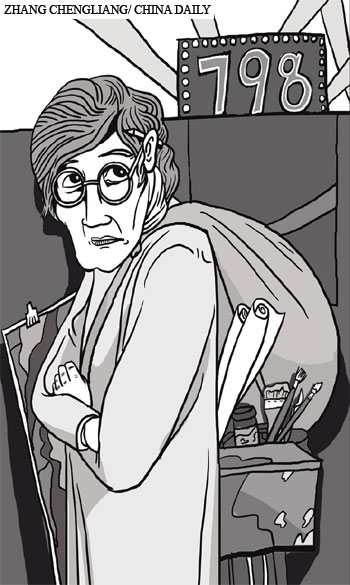Comment
798 sculpts pure kitsch
By Todd Balazovic (China Daily)
Updated: 2010-04-21 10:50
 |
Large Medium Small |

A recent visit to 798, the capital's best-known avant-garde art district, has left this Beijinger feeling less than inspired.
After spending more than two hours floating through 798's maze of industrial pipelines and hybrid coffee shop/art galleries, I realized that its days of art for art's sake have fizzled out.
While there are still certainly occasional flickers of brilliance scattered through the streets and alleys of the district, they have been blotted out by the shadow of overinflated egos and eager moneymakers.
Once an ugly industrial factory space used to produce electronics, the area has recently begun returning to its industrial roots, but this time around replacing wires with the wired - overzealous entrepreneurs chasing the buck while hopped up on lattes.
The streets seem more filled with artful dodgers than artists.

What was billed as the last bastion of art culture in Beijing now resembles the bowels of the Eiffel Tower, with hordes of trinket pushers pawning rip-offs of reprints, reprints of rip-offs - all reproduced for seemingly ripped-off tourists.
It would make the rosy cheeks of a cheap Russian babushka doll blush three shades redder.
One art space owner even went so far as to tell me he had decided to close his art space to the public, making it invitation-only. I assume invitations would be printed on golden tickets.
As with most kitschy tourist locations in the world, the art space still earns the merit of a hurried stroll. But visitors walking the gilded streets should be wary not to become intoxicated by the fumes of freshly brushed lacquer; you might be duped into buying a cookie-cutter reprint sporting the price tag of an original.
Like relics of an ancient civilization, the occasional piece of thought-provoking installation art, leftovers from the zone's "happier" times, still evoke wonder in visitors, but the visual efforts are lost among the bombardment of banners, advertisements and shops hawking silk market wares.
For diehard fans, or those on guided tours, crumbs of creativity can still be seen in the anonymous bits of brightly colored graffiti spray-painted on the walls of the old industry buildings. But even these scraps of originality are being washed over with a layer of sterile white paint.
Perhaps it would be best if the artists in the 798 community followed suit and started with a blank canvas.
Art-seekers in search of something more meaningful than an overpriced fridge magnet need not despair. Beijing's founding 798 artists might have abandoned their proverbial ship in a bottle - an area that was once an insulated haven of cutting-edge creativity - but the real talent has not set sail from Beijing.
Instead, they have split up and found refuge in small communities scattered along the outskirts of the city, momentarily safe from the enterprising taint of the inner city.
With places such as Caochangdi and Songzhuang quickly budding, it might not take long to see the refreshed efforts of Beijing's more innovative artists bear fruit, fruit that will most likely be dotted with neon colors.
We can only hope that the artists in these developing communities turn their backs toward businessmen in cheap sunglasses and point their eyes toward whatever inspired the area's original dazzling ingenuity.
As for me, I went to 798 and all I got was this lousy column.
| 分享按钮 |